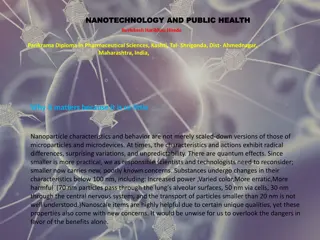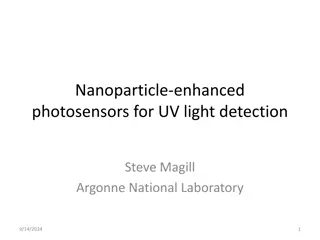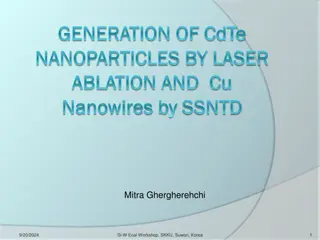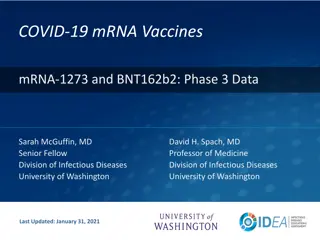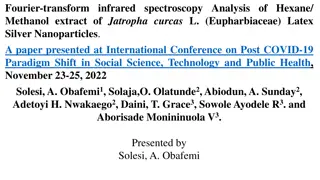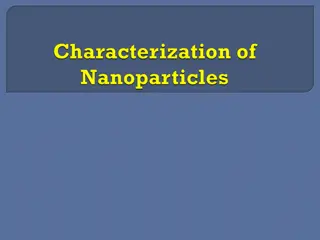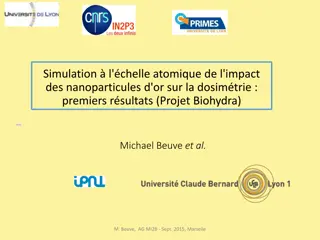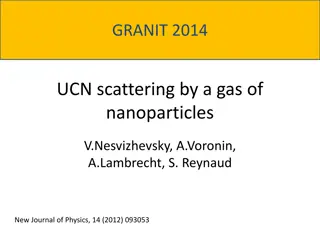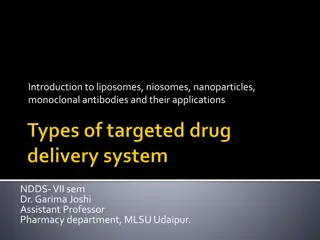Nanotoxicology and Nanoparticles in Study
Nanotoxicology is the study of the toxicity of nanomaterials due to unique properties at nanometer dimensions. This branch of bionanoscience explores the potential threats nanoparticles pose to the environment and human health. Studied nanoparticles include titanium dioxide, alumina, and zinc oxide. Diesel nanoparticles have been linked to cardiovascular damage. Nanoparticles can be manufactured or naturally occurring, such as those from volcanic eruptions. Understanding nanoparticle behavior is crucial for assessing their impact.
Download Presentation

Please find below an Image/Link to download the presentation.
The content on the website is provided AS IS for your information and personal use only. It may not be sold, licensed, or shared on other websites without obtaining consent from the author.If you encounter any issues during the download, it is possible that the publisher has removed the file from their server.
You are allowed to download the files provided on this website for personal or commercial use, subject to the condition that they are used lawfully. All files are the property of their respective owners.
The content on the website is provided AS IS for your information and personal use only. It may not be sold, licensed, or shared on other websites without obtaining consent from the author.
E N D
Presentation Transcript
Nanotoxicology PM 10 Ultrafine Respirable PM 2.5 100 nm 1 m10 m 1 nm 10 nm
Particle Scale PM 10 Ultrafine Respirable PM 2.5 Nanoparticles 10 m 1 m 1 nm 10 nm 100 nm
Definitions- Particle Size PM 10 Ultrafine Respirable PM 2.5 100 nm 1 m 10 m 1 nm 10 nm Nano = Ultrafine = < 100 nm Nano = <10 nm Fine = 100 nm - 3 m
Nanotoxicology is the study of the toxicity of nanomaterials. Because of quantum size effects and large surface area to volume ratio, nanomaterials have unique properties compared with their larger counterparts.
Nanotoxicology is a branch of bionanoscience which deals with the study and application of toxicity of nanomaterials. Nanomaterials, even when made of inert elements like gold, become highly active at nanometer dimensions.
Nanotoxicological studies are intended to determine whether and to what extent these properties may pose a threat to the environment and to human beings.[2]For instance, Diesel nanoparticles have been found to damage the cardiovascular system in a mouse model
1-Manufactured nanotubes 2- naturally occurring nanoparticles from volcanic eruptions, atmospheric nanoparticles like carbon chemistry etc.
Typical nanoparticles that have been studied are titanium dioxide, alumina, zinc oxide
In addition, some nanoparticles seem to be able to translocate from their site of deposition to distant sites such as the blood and the brain.
Interparticle Forces And Surface Chemistry Will Be Influenced By Size And Whether Particles Are Individual or Aggregates & Agglomerates Mechanical interlocking Single particle Capillary (surface tension) Van der Waals (cohesive force 1/d**2) Chemical bonds Equivalent dia. ~2 x Equivalent diameters of 10-1000x are common Settling velocity ~3-4 x
These properties influence lung deposition as well as toxicity. Ultra-fine or nanoparticles may deposit as aggregates due to high Van DerWaals forces, rather than discrete particles. If an inhaled particle with a diameter of 50 100 nm forms an aggregate of 5 10 particle types, in terms of deposition it may have the properties of a 200 500 nm particle .
From a large-scale literature review, release of airborne associated worker various production activities at different workplaces are very probable.[5] engineered nanoparticles and exposure and from handling
Carbon nanotubes characterized by their microscopic size frequently likened to asbestos,due to their needle-like fiber shape.
raising concerns that exposure to carbon nanotubes may lead to (cancer of the lining of the lungs caused by exposure to asbestos).[8]
Handling nanotube material Raw single walled nanotube material
The exposure was highlighted by the 2004 Royal Society report[11] recommended existing regulations to assess and control exposure potential for workplace which a review of workplace
to nanoparticles and nanotubes. The report expressed particular concern for the inhalation of large quantities of nanoparticles by manufacturing process. workers involved in the
The greater chemical reactivity of nanomaterials can result in increased production of reactive oxygen species (ROS),including free radicals.[
ROS production has been found in a diverse range of nanomaterials including carbon nanotubes and nanoparticle metal oxides fullerenes, carbon
ROS primary mechanisms of nanoparticle toxicity;it may result in oxidative stress, inflammation, and consequent damage to proteins,membranes and DNA.[13] and free radical production is one of the
Biodistribution The extremely small size of nanomaterials also means that they much more readily gain entry into the human body than larger sized particles. How these nanoparticles behave inside the body is still a major question that needs to be resolved..
The behavior of nanoparticles is a function of their size, shape and surface reactivity with the surrounding tissue. In principle, a large number of particles could overload the body's phagocytes,
cells that ingest and destroy foreign matter, thereby triggering stress reactions that lead to inflammation and weaken the body s defense against other pathogens
In addition to questions about what happens if non- degradable or slowly degradable nanoparticles accumulate in bodily organs, another concern is their potential interference with biological processes inside the body.. interaction or
Nanomaterials are able to cross biological membranes and access cells, tissues and organs that larger-sized particles normally cannot.[14] Nanomaterials can gain access to the blood stream via inhalation[15]or ingestion.[16]
At skin;[17] barrier,[19]suggesting that acne,eczema least some Broken nanomaterials skin can ineffective penetrate the is an particle
having wounds or severe sunburn may accelerate skin uptake of nanomaterials.Then,once in the blood stream, nanomaterials can be transported around the body and be taken up by organs and tissues, including the brain, heart, liver, kidneys, spleen, bone marrow and nervous system.[
19]Nanomaterials have proved toxic to human tissue and cell cultures, resulting in increased oxidative stress, inflammatory cytokine production and cell death.[15]
Unlike larger particles, nanomaterials may be taken up by cell mitochondria[20]and the cell nucleus.[21][22]Studies demonstrate the potential cause DNA mutation[22]and induce major structural damage to mitochondria,even resulting in cell death.[20][23] for nanomaterials to
the cells with which they come into contact including but not limited to DNA breakage and oxidation, mutations, reduced cell viability, induced apoptosis and warped necrosis, morphology, decreased proliferation.[30 and
Cytotoxicity[ A primary marker for the damaging effects of NPs has been cell viability. Cells exposed to metallic NPs have, in the case of copper oxide, had up to 60% of their cells rendered unviable.[30]
, the positively charged metal ions often experience an electrostatic attraction to the cell membrane of nearby cells, covering the membrane and preventing it from permeating the necessary fuels and wastes.[30]
for transportation and communication,the cells are often rendered inactive. NPs have been found to induce apoptosis in certain cells primarily due to the mitochondrial damage and oxidative stress brought on by the foreign NPs electrostatic reactions
Thanks for your attention





